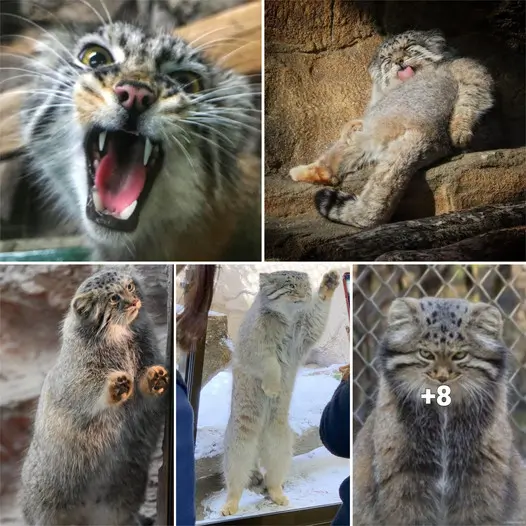We are two journalists from Yomiuri Shimbun who share a deep love for cats. Whenever we are not around our feline friends, we yearn for their comforting presence. Just the thought of cats excites us to no end. However, with our busy schedules, we have been deprived of the nourishing effect they have on us. Therefore, we have set off in search of something more unique, something special – and Pallas’s cats seem to fit the bill!

As the saying goes, “The best day to start working on an idea is the day you conceive it.” So, we embarked on a journey to Nasu Animal Kingdom in Tochigi Prefecture, where we could find two Pallas’s cats.
Pallas’s cats, also known as manul, are believed to be the oldest species in the Felidae family. They are known for their distinctive look with round pupils, wide eyes, and thick fur. They inhabit the plains of countries on the Eurasian continent, such as Russia and Mongolia.
Bol, a seven-year-old male Pallas’s cat born in Japan, and Polly, a six-year-old female that came from Sweden, reside in Nasu Animal Kingdom. Their videos showcasing their peculiar hunting methods and varied facial expressions went viral, making them popular among Pallas’s cat enthusiasts.
During our visit to Nasu Animal Kingdom, their publicity officer, Sayaka Miyachi, guided us to the exhibition room where the two Pallas’s cats resided. Bol greeted us as soon as we arrived, sitting silently on a stump in front of a glass wall that separated the cats from the spectators. His round, furry presence was even more adorable than we imagined, making us scream like enthusiastic pop star fans. Their wide, powerful eyes were particularly striking.
According to Yuri Chiba, an animal keeper at the facility, Pallas’s cats’ horizontal pupils are one of their distinctive traits, making their facial expressions unique. It’s believed that these pupils might not provide an advantage for survival in the wild.
Overall, our encounter with Pallas’s cats was a memorable experience for us. Their distinctive appearance and expressive eyes make them stand out among other cat species.
Polly, a Pallas’ cat who loves to walk on snow, caught our attention as she approached us with her thick fur coat. These cats are naturally found in Central Asia, where the weather is extreme with hot summers and cold winters. Their furry appearance demonstrates how they are adapted to survive in harsh environments. Despite their wild nature, they can live comfortably in Japan’s cold winters. When we visited them, Polly seemed to be stalking prey, moving slowly and carefully just like when they hunt. While they are cute, they still maintain their wild instincts, and they rarely meow. Male cats only meow during the breeding season, and otherwise, they give menacing hisses. The facility supports their natural behavior and helps them maintain their wildness.
Bol, the Pallas’s cat, stretches his body as he lounges around. It’s impossible to hold these cool cats in your arms. According to a source, when entering the exhibition room, protective gear is necessary to avoid getting hurt. The sight of Pallas’s cats devouring horsemeat is definitely a must-see! They seem to be saying, “Don’t underestimate us!” Polly’s attitude reminded us that Pallas’s cats were once threatened by indiscriminate hunting for their fur, which caused a rapid decline in their population. Although they are now classified as “least concern,” it is important to note that zoos and animal parks in Japan have taken measures to protect them. These cats, which naturally inhabit high altitudes and are susceptible to contagious diseases, remain full of energy and curiosity even in captivity. Pallas’s cats are not only adorable but also fascinating animals with diverse expressions and movements. After being captivated by their charm, we are more determined than ever to raise awareness about protecting these amazing cats. We hope to see them again soon!

